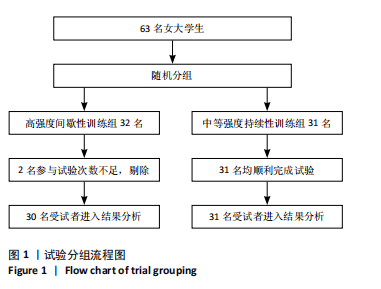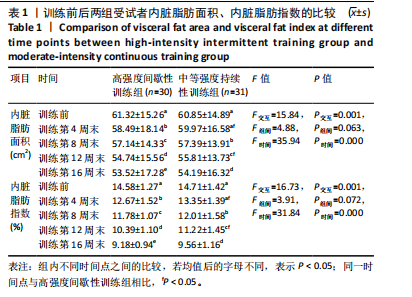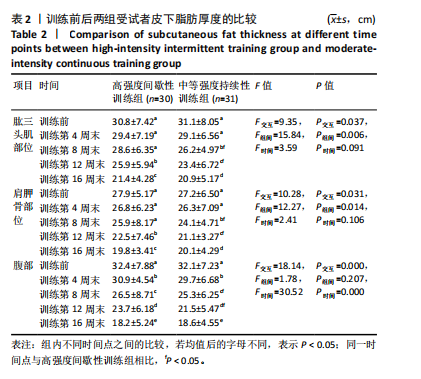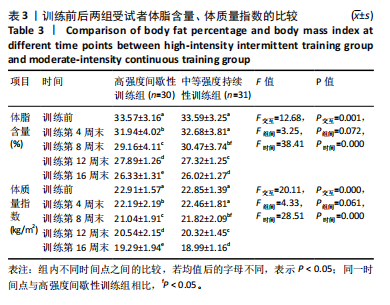[1] SMITH CJ, PERFETTI TA, HAYES AW, et al. Obesity as a source of endogenous compounds associated with chronic disease: a review. Toxicol Sci. 2020;175(2):149-155.
[2] 中国营养学会肥胖防控分会,中国营养学会临床营养分会,中华预防医学会行为健康分会,等.中国居民肥胖防治专家共识[J].中国预防医学杂志,2022,23(5):321-339.
[3] CHAIT A, DEN HARTIGH LJ. Adipose tissue distribution, inflammation and its metabolic consequences, including diabetes and cardiovascular disease. Front Cardiovasc Med. 2020;52(7):22.
[4] SAWAKI D, CZIBIK G, PINI M, et al. Visceral adipose tissue drives cardiac aging through modulation of fibroblast senescence by osteopontin production. Circulation. 2018;138(8):809-822.
[5] RAINE L, DROLLETTE E, KAO SC, et al. The associations between adiposity, cognitive function, and achievement in children. Med Sci Sports Exerc. 2018;50(9):1868-1874.
[6] 葛迎春,杨斌,吉冬梅.GDM患者脂肪组织中HMGB1表达与产后糖代谢异常的关系[J].中国妇幼健康研究,2022,33(3):105-110.
[7] 彭怀玉,钟勇进,高雨蕉,等.下肢动脉硬化性闭塞症病人术前血清瘦素、艾帕素、内脏脂肪特异性丝氨酸蛋白酶抑制物水平与介入治疗后复发相关性[J].安徽医药,2023,27(3):461-465.
[8] 屈雯慧.18周体育舞蹈训练对隐性肥胖女大学生体成分及骨密度的影响[J].中国应用生理学杂志,2020,36(1):82-84.
[9] PLAVSIC L, KNEZEVIC OM, SOVTIC A, et al. Effects of high-intensity interval training and nutrition advice on cardiometabolic markers and aerobic fitness in adolescent girls with obesity. Appl Physiol Nutr Metab. 2020;45(3):294-300.
[10] 王玮,管延飞.大强度间歇训练促进有氧耐力和健康的研究进展[J].中国康复理论与实践,2016,17(1):13-18.
[11] 齐玉刚,黄津虹,谭思洁.HIIT和持续性有氧运动对肥胖女大学生减肥效果的比较研究[J].中国体育科技,2013,49(1):30-33.
[12] 陈建明,吴大政,苏美华.HIIT与MICT训练对女大学生的减脂效果研究[J].长春中医药大报,2021,31(8):32-37.
[13] 梁晋裕,郝亮.高强度间歇运动对肥胖儿童身体成分血压及血清Chemerin的影响[J].中国学校卫生,2018,39(11):1729-1732.
[14] 李抒,曹甍,邹昱,等.高强度间歇训练对肥胖儿童内脏脂肪和心肺适能的影响[J].体育学刊,2023,30(4):138-144.
[15] VERHEGGEN R, MAESSEN M, GREEN DJ, et al. A systematic review and meta-analysis on the effects of exercise training versus hypocaloric diet:distinct effects on body weight and visceral adipose tissue. Obesity Rev. 2016;17(8):664-690.
[16] DIAS KA, INGUL CB, TINNA AE, et al. Effect of high-intensity interval training on fitness,fat mass and cardiometabolic biomarkers in children with obesity:A randomised controlled trial. Sports Med. 2017;48(3):733-746.
[17] 王京京,韩涵,张海峰.高强度间歇训练对青年肥胖女性腹部脂肪含量的影响[J].中国运动医学杂志,2015,34(1):15-20.
[18] 许胜利.不同运动处方对肥胖职业女性减肥效果及其心理影响的观察[J].现代预防医学,2008,35(15):2876-2877,2887.
[19] 张勇,王典,叶卫兵.高强度间歇运动与最大脂肪氧化强度持续运动对普通女大学生身体成分的影响[J].中国运动医学杂志,2018, 37(5):384-390.
[20] MAILLARD F, ROUSSET S, PEREIRA B, et al. High-intensity interval training reduces abdominal fat mass in postmenopausal women with type 2 diabetes. Diabetes Metab. 2016;42(6):433-441.
[21] AINSWORTH BE, HASKELL WL, LEON AS, et al. Compendium of physical activities: Classification of energy costs of human physical activities. Med Sci Sports Exerc. 1993;25(1):71-80.
[22] FRIEDENREICH CM, NEILSON HK, O’REILLY R, et al.Effects of a high vs moderate volume of aerobic exercise on adiposity outcomes in postmenopausal women:a randomized clinical tria. JAMA Oncol. 2015; 11(6):766-776.
[23] 王淑珍,杨莉萍,白晨,等.哺乳期与非哺乳期青年女性减肥效果的实验研究[J].中国食物与营养,2008,9(2):57-60.
[24] KIM J. Experiences of health related lifestyles in high body fat but non-obese female college students in Korea. Osong Public Health Res Perspect. 2014;5(1):68-73.
[25] KIM MK, HAN K, KWON HS, et al. Normal weight obesity in K orean adults. Clin Endocrinol. 2014;80(2):214-220.
[26] MADEIRA FB, SILVA AA, VELOSO HF, et al. Normal weight obesity is associated with metabolic syndrome and insulin resistance in young adults from a middle-income country. PLoS One. 2013;8(3):e60673.
[27] 王梦蝶,任弘,白妍,等.高校女大学生隐性肥胖的影响因素分析[J].中国学校卫生,2020,41(7):1061-1065.
[28] SIJIE T, HAINAI Y, FENGYING Y, et al. High intensity interval exercise training in overweight young women. J Sports Med Phys Fitness. 2012; 52(3):255-262.
[29] 王瑞元,苏全生.运动生理学[M].北京:人民体育出版社,2012:194.
[30] CARTER JEL. The Heath-Carter Somatotype Method. 3rd. San Diego:San Diego State University Press. 1980:58-94.
[31] 刘兴.高强度间歇训练与中低强度持续训练对健身俱乐部中年男会员减脂效果比较研究[D].荆州:长江大学,2022.
[32] 刘军,侯莉莉.高强度间歇训练与中等强度持续训练对超重青年女性心肺功能及体成分影响机制研究[G].中国体育科学学会,第十二届全国体育科学大会论文摘要汇编.北京:北京体育大学出版社,2022:29.
[33] 王松涛,张龙,罗博,等.间歇性运动和持续性运动的能耗比较[C].中国体育科学学会运动生理与生物化学分会,第四届(2016)全国运动生理与生物化学学术会议.北京:北京体育大学出版社,2016:37.
[34] TREMBLAY A, SIMONEAU JA, BOUCHARD C. Impact of exercise intensity on body fatness and skeletal muscle metabolism. Metabolism. 1994; 43(7):814-818.
[35] POEHLMAN ET, DANFORTH JR E. Endurance training increases metabolic rate and norepinephrine appearance rate in older individuals. Am J Physiol Endocrinol Metab. 1991;261(2):233-239.
[36] GALBO H, HOLST JJ, CHRISTENSEN NJ. The effect of different diets and of insulin on the hormonal response to prolonged exercise. Acta Physiol Scand. 1979;107(1):19-32.
[37] HACKNEY AC, VIRU A. Twenty‐four‐hour cortisol response to multiple daily exercise sessions of moderate and high intensity. Clin Physiol. 1999;19(2):178-182.
[38] ROSS R, JANSSEN I, DAWSON J, et al. Exercise‐induced reduction in obesity and insulin resistance in women: a randomized controlled trial. Obes Res. 2004;12(5):789-798.
[39] FIGUEROA A, GOING SB, MILLIKEN LA, et al. Effects of exercise training and hormone replacement therapy on lean and fat mass in postmenopausal wome. J Gerontol A Biol Sci Med Sci. 2003;58(3):266-270.
[40] TRAPP EG, CHISHOLM DJ, FREUND J, et al. The effects of high-intensity intermittent exercise training on fat loss and fasting insulin levels of young women. Int J Obes(Lond). 2008;32(4):684-691.
[41] KONG Z, FAN X, SUN S, et al. Comparison of high-intensity interval training and moderate-to-vigorous continuous training for cardiometabolic health and exercise enjoyment in obese young women: a randomized controlled trial. PLoS One. 2016;11(7):1-16.
[42] BOUTCHER SH. High-intensity intermittent exercise and fat loss. J Obes. 2011;24(8)1-10.
[43] IRVING BA, DAVIS CK, BROCK DW, et al. Effect of exercise training intensity on abdominal visceral fat and body composition. Med Sci Sports Exerc. 2018;50(9):1740-1748.
[44] ROSS R, DAGNONE D, JONES PJ, et al. Reduction in obesity and related comorbid conditions after diet-induced weight loss or exercise-induced weight loss in men: a randomized, controlled trial. Ann Intern Med. 2000;133(2):92-103.
[45] LEE S, KUK JL, DAVIDSON LE, et al. Exercise without weight loss is an effective strategy for obesity reduction in obese individuals with and without type 2 diabetes. J Appl Physiol. 2001;99(3):1220-1225.
[46] GIBALA MJ, LITTLE JP, MACDONALD MJ, et al. Physiological adaptations to low-volume, high-intensity interval training in health and disease. J Physiol. 2012;590(5):1077-1084.
[47] GARAULET M, PÉREZ-LLAMAS F, BARAZA JC, et al. Body fat distribution in pre-and post-menopausal women: metabolic and anthropometric variables. J Nutr Health Aging. 2002;6(2):123-126.
[48] KUK JL, KATZMARZYK PT, NICHAMAN MZ, et al. Visceral fat is an independent predictor of all-cause mortality in men. Obesity (Silver Spring). 2006;14(2):336-341.
[49] MANOLOPOULOS KN, KARPE F, FRAYN KN. Gluteofemoral body fat as a determinant of metabolic health. Int J Obes. 2010;34(5):949-959.
[50] KEATING SE, MACHAN EA, O’CONNOR HT, et al. Continuous exercise but not high intensity interval training improves fat distribution in overweight adults. J Obes. 2014;23(10):834-865. |




